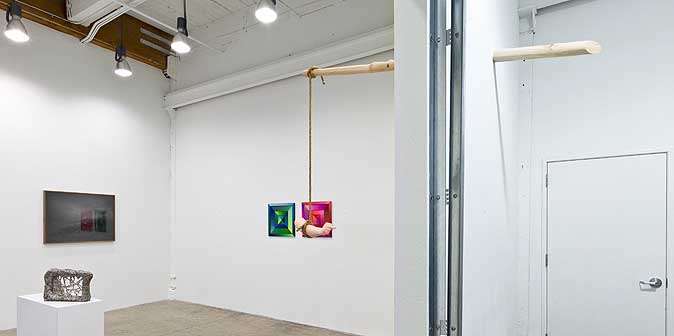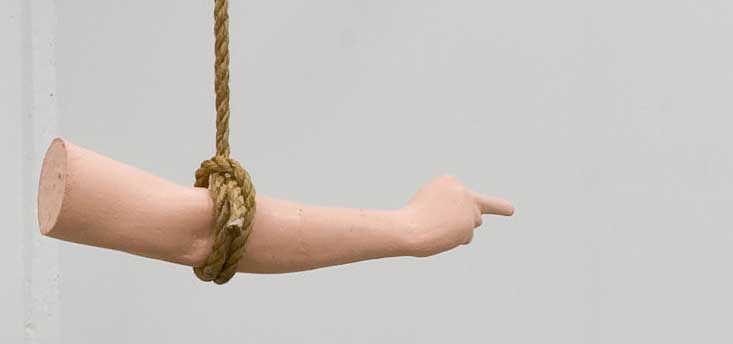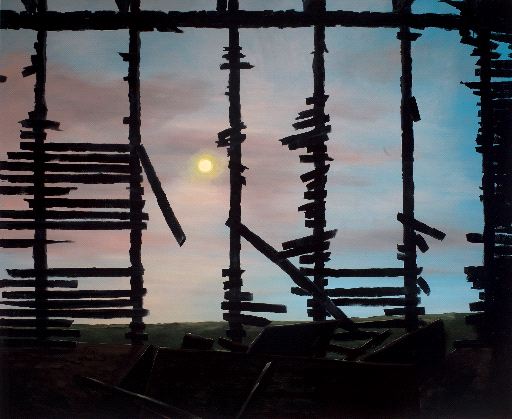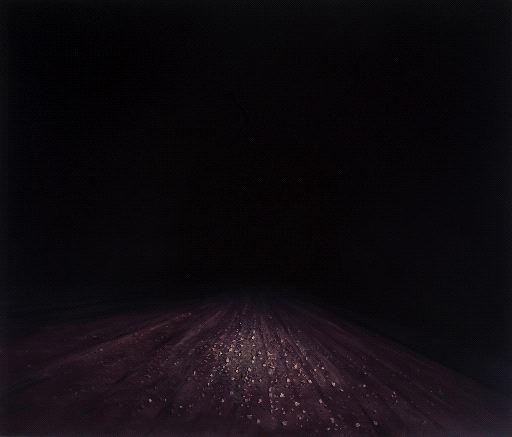
|
||
|
Portland art blog + news + exhibition reviews + galleries + contemporary northwest art
|
||
Revisiting Specific Summer Objects There are some good shows that come down this weekend but as July comes to
a close my mind drifts to a few other specific objects that beg to be looked
at again.
 (Right) Patrick Rock's Never Give An Inch, 2009 Fourteen 30's current group show is your typical summer potpourri fare but it does paint a remarkably good portrait at this new gallery's maiden year and generally very Californian gist. Sure, Nick Van Woert's studies in baroque narcissism are cool in a oh so LA way (I prefer his more constructivist stuff) but it is Patrick Rock's Never Give an Inch that is most memorable and least regionally definable (stylistically, it's pretty Bruce Nauman which we dont see a lot around here).  (Detail) Never Give An Inch Puncturing walls, hung by a rope and flipping us the bird in a new way, it has style not unlike Kippenberger but it with an odd dignity big K could never manage, also separating it from the constant barrage of Kippenberger clones. Instead, it deftly conveys the attitude that disrespect is a form of respect in art. Unlike MK it draws a line…sure, it's a line in the sand (ala Rauschenberg or Yves Klein) but that is important. Sometimes, irreconcilable differences don't need reconciling… that would be like taming all of the wild animals. Kippenberger clones often lose their edge by chasing it; whereas Kippenberger himself made the mistake of overstating his case by always making art but Rock… he's got (pardon the pun) balance. In short this sculpture can give an inch… it's on a rope, its ridiculous… yet it seems serious about not giving any ground, even though it clearly can. Little boys like to make all sorts of challenges in the hopes of landing a punch, while bigger boys like Rock take a few shots at themselves before proclaiming just how badass they are. After seeing this piece I ask, is anyone in Portland more overdue for a solo show than Patrick Rock? I think this problem is more Portland's more than Patrick's. So Portland, you gonna take that? Huh?  Michael Brophy's Start, 2009 Michael Brophy's latest solo show Silence, still has the gifted artist trying to get his sea legs back after a fire rocked his life, effecting all corners of his existence. And though there is a general sense that Brophy has found some inner peace, this show of mostly excellent work still feels a little disjointed (especially when reconciling night and day scenes with one another). Now disjointed isn't a bad thing when it is honest and Brophy is nothing if not an honest painter. In fact, the day scenes often show the moon, alluding to this "only natural" disruption and tidal shifts on a philosophical level. When life turns things upside down it is time to reflect and that's just what Brophy is doing. Brophy's painting Start is one of his best works… it's viewpoint peers from the slatted wreckage of a structure… (his home and studio?) looking out on the open plains and sky. Since it is called Start Im assuming it is a morning scene. It is wonderfully painted and probably sums up Brophy's public face, with everyone asking how things have been since the fire "starting" is about all you can do if you don't want to wallow?  Brophy's Silence #7 Yet it is Silence #7 that steals the show. With it's dirt road illuminated at night it is probably Michael Brophy's best work to date and a metaphor for taking it one step at a time… the unknown being the darkness. It is also a piece that sums up the current zeitgeist in a way that is knowing and poetic. It's also a highly original scene that updates Cezanne's roads in interesting ways. Sure Brophy's got some answers here, but its mostly about the journey… not life's destination. I sense the fire is becoming a place that only exists in the past and maybe some of the earlier paintings in this show. Brophy is moving on and it's some of his coolest and most philosophically mature work ever. Posted by Jeff Jahn on July 30, 2009 at 18:09 | Comments (5) Comments Never give an inch is the motto of the main character in Ken Kesey's novel Sometimes a Great Notion about an Oregon logging family. The disembodied arm plays a role in the novel's climax. The film was also advertised as Never Give an Inch. So it is hyper regional. Posted by: Criticaleye-notpen Interesting... it can be both hyper regional and international because the two sets intersect in the source material. Being from the film and literary lexicons it is also interfacing Hollywood, etc... which requires nothing but knowledge of the source material. Regretably, it is rare for Oregon artists to make literary and film references to the work of Oregon writers and films with an Oregon connection. Needless to say Ive avoided Kesey on purpose (saving it for a TBD intensive summer or winter reading/watching fest) so I am not terribly hyper-regional in my reading and film viewing. (I keep watching Twin Peaks though) Posted by: Double J In the Kesey original it's actually "NEVER GIVE A INCH!", intentionally misspelled. And the arm is a powerful metaphor in the opening pages of Sometimes a Great Notion: "Twisting and stopping and slowly untwisting in the gusting rain, eight or ten feet above the flood's current, a human arm, tied at the wrist, (just the arm; look) disappearing downward at the frayed shoulder where an invisible dancer performs twisting pirouettes for an enthralled audience (just the arm, turning there, above the water) ..." Needless to say, you should read this novel. Posted by: ligeti42 Sounds like a good place to start, but I want to devote my full concentration to it when I ge to it (I prefer to explore an entiire body of work, not just one or two things) . It is also interesting how Rock's piece stands alone even without the referent. It seems less tragic, and a little more combative. When I first saw it it reminded me of the colonial flag, "don't tread on me" Posted by: Double J Not to overly dwell on the subject, but in Kesey's novel the arm is thoroughly defiant, a giant "up yours" from the Stamper clan which refuses to bow to the logging union. That tension runs through the novel and represents one of its principal themes, the 'notion' of individual vs. communal responsibility. I'd suggest that Rock's piece rides on Kesey's coattails in no small way. On another note, many thanks for this blog, which for this relatively new PDXer (two years now) has been an important conduit to substantive discussion of the arts in Portland. Posted by: ligeti42 Post a comment Thanks for signing in, . Now you can comment. (sign out)
(If you haven't left a comment here before, you may need to be approved by
the site owner before your comment will appear. Until then, it won't appear
on the entry. Thanks for waiting.)
|
| s p o n s o r s |
 |
 |
 |
 |
 |
 |
 |
 |
 |
 |
 |
 |
 |
 |
 |
 |

|
Site Design: Jennifer Armbrust | • | Site Development: Philippe Blanc & Katherine Bovee | |


![[TypeKey Profile Page]](http://www.portlandart.net/nav-commenters.gif)